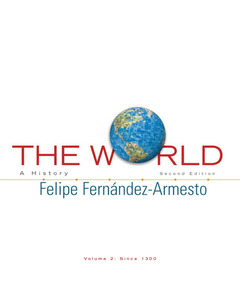The world (2nd ed )
Auteur : FERNANDEZ-ARMESTO Felipe

The Worldinterweaves two stories-of our interactions with nature and with each other. The environment-centered story is about humans distancing themselves from the rest of nature and searching for a relationship that strikes a balance between constructive and destructive exploitation. The culture-centered story is of how human cultures have become mutually influential and yet mutually differentiating. Both stories have been going on for thousands of years. We do not know whether they will end in triumph or disaster.
There is no prospect of covering all of world history in one book. Rather, the fabric of this book is woven from selected strands. Readers will see these at every turn, twisted together into yarn, stretched into stories. Human-focused historical ecology-the environmental theme-will drive readers back, again and again, to the same concepts: sustenance, shelter, disease, energy, technology, art. (The last is a vital category for historians, not only because it is part of our interface with the rest of the world, but also because it forms a record of how we see reality and of how the way we see it changes.) In the global story of human interactions-the cultural theme-we return constantly to the ways people make contact with each another: migration, trade, war, imperialism, pilgrimage, gift exchange, diplomacy, travel-and to their social frameworks: the economic and political arenas, the human groups and groupings, the states and civilizations, the sexes and generations, the classes and clusters of identity.
Volume 2: Chapters 13-30
Volume A: Chapters 1-10
Volume B: Chapters 11-20
Volume C: Chapters 20-30
In Perspective: Cains and Abels
PART 6: the crucible: the eurasian crises of the thirteenth and fourteenth centuries
Chapter 13
The World the Mongols Made
The Mongols: Reshaping Eurasia
- Genghis Khan
- The Mongol Steppe
The Mongol World Beyond the Steppes: The Silk Roads, China, Persia, and Russia
- China
- Persia
- Russia
The Limits of Conquest: Mamluk Egypt and Muslim India
- Mamluk Egypt
- Muslim India: The Delhi Sultanate
Europe
In Perspective: The Uniqueness of the Mongols
Chapter 14
The Revenge of Nature: Plague, Cold, and the Limits of Disaster in the Fourteenth Century
Climate Change
The Coming of the Age of Plague
- The Course and Impact of Plague
- Medicine and Morals
- The Jews
- Distribution of Wealth
- Peasant Millenarianism
The Limits of Disaster: Beyond the Plague Zone
- India
- Southeast Asia
- Japan
- Mali
The Pacific: Societies of Isolation
- Easter Island
- New Zealand
- Ozette
- Chan Chan
In Perspective: The Aftershock
Chapter 15
Expanding Worlds: Recovery in the Late Fourteenth and Fifteenth Centuries
Fragile Empires in Africa
- East Africa
- West Africa
Ecological Imperialism in the Americas
- The Inca Empire
- The Aztec Empire
New Eurasian Empires
- The Russia Empire
- Timurids and the Ottoman Empire
The Limitations of Chinese Imperialism
The Beginnings of Oceanic Imperialism
The European Outlook: Problems and Promise
In Perspective: Beyond Empires
Part 7: Convergence and Divergence to ca. 1700
Chapter 16
Imperial Arenas: New Empires in the Sixteenth and Seventeenth Centuries
Maritime Empires: Portugal, Japan, and the Dutch
- The Portuguese Example
- Asian Examples
- The Dutch Connection
Land Empires: Russia, China, Mughal India, and the Ottomans
- China
- The Mughal Example in India
- The Ottomans
New Land Empires in the Americas
- Making the New Empires Work
In Perspective: The Global Balance of Trade
Chapter 17
The Ecological Revolution of the Sixteenth and Seventeenth Centuries
The Ecological Exchange: Plants and Animals
- Maize, Sweet Potatoes, and Potatoes
- Weeds, Grasses, and Livestock
- Cane Sugar
- Coffee, Tea, and Chocolate
- Patterns of Ecological Exchange
The Microbial Exchange
- Demographic Collapse in the New World
- Plague and New Diseases in Eurasia
Labor: Human Transplantations
Wild Frontiers: Encroachi
Date de parution : 02-2009
Ouvrage de 696 p.
22.9x27.3 cm



